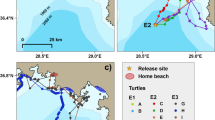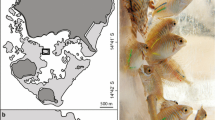Abstract
Although navigation is common in many animals, only a few perform true navigation, meaning that they have the ability to return to a given place by relying on indirect cues obtained at the release site (i.e., by relying on information from a “map and compass” mechanism). The common intertidal fish, Lipophrys pholis, is thought to have homing abilities through a mechanism that primarily makes use of familiar landmarks (i.e., piloting). Anecdotal reports that individuals return to their home pools after release at unfamiliar sites suggest that L. pholis might use cues collected at the release site to find their way back (i.e., they might use map and compass information). Using a completely artificial setup, we tested the homing abilities of L. pholis as a function of age, sex, and familiarity with the release site. The findings showed that motivation for homing is present only in the adult phase and is independent of sex and/or familiarity with the release site. Moreover, adults released at a completely unfamiliar place oriented themselves in a direction roughly similar to that of their home pools. The fact that L. pholis were tested in a complete artificial environment means that hydrodynamic cues can be excluded as playing a role in this process and restricts the candidate options (e.g., magnetic cues). The ability to perform navigation based on a “map and compass” mechanism raises many interesting questions about the learning process, once these individuals have restricted home ranges during their lives. In vertebrate navigation, the cues used during the navigation process are a question of debate, and L. pholis offers an outstanding model to test hypotheses and ultimately provide answers.






Similar content being viewed by others
References
Almada V, Dores J, Pinheiro A, Santos RS (1983) Contribuição para o estudo do comportamento de Coryphoblennius galerita (L.) (Pisces: Blenniidae). Mem Mus Mar Ser Zool 2:1–165
Almada VC, Barata E, Gonçalves EJ, Oliveira R (1990a) On the breeding season of Lipophrys pholis (Pisces: Blenniidae) at Arrábida, Portugal. J Mar Biol Assess UK 70:913–916
Almada VC, Oliveira R, Barata E, Gonçalves EJ, Rito A (1990b) Field observations on the behaviour of the breeding males of Lipophrys pholis (Pisces: Blenniidae). Portugaliae Zoologica 1:27–36
Almada VC, Gonçalves EJ, Oliveira RF, Barata EN (1992) Some features of the territories in the breeding males of the intertidal blenny Lipophrys pholis (Pisces: Blenniidae). J Mar Biol Assoc UK 72:187–197
Alyan SH (1996) Evidence for resetting the directional component of path integration in the house mouse (Mus musculus). Ethology 102:629–638
Arondson IR (1951) Orientation and jumping behavior in the gobiid fish Bathygobius soporator. Amer Mus Novit 1480:1–22
Batschelet E (1981) Circular statistics in biology. Academic Press, London
Burt de Perera T, Guilford TC (2008) Rapid learning of shelter position in an intertidal fish, the shanny Lipophrys pholis L. J Fish Biol 72:1386–1392
Collett TS, Graham P (2004) Animal navigation: path integration, visual landmarks and cognitive maps. Curr Biol 14:R475–R477
Dittman AH, Quinn TP (1996) Homing in Pacific salmon: mechanisms and ecological basis. J Exp Biol 199:83–91
Dodd J, Gibson RN, Hughes RN (2000) Use of cues by Lipophrys pholis L. (Teleostei, Blenniidae) in learning the position of a refuge. Behav Process 49:69–75
Etienne AS, Maurer R, Berlie J, Georgakopoulos J, Reverdin B, Rowe T, Séguinot V (1998) Navigation through vector addition. Nature 396:161–164
Etienne AS, Maurer R, Boulens V, Levy A, Rowe T (2004) Resetting the path integrator: a basic condition for route-based navigation. J Exp Biol 207:1491–1508
Faria C, Almada V (2006) Patterns of spatial distribution and behaviour of fish on a rocky intertidal platform at high tide. Mar Ecol Prog Ser 316:155–164
Ferreira F, Santos MM, Reis-Henriques MA, Vieira NM, Monteiro NM (2010) Sexing blennies using genital papilla morphology or ano-genital distance. J Fish Biol 77:1432–1438
Gibson RN (1967) Studies on the movements of littoral fish. J Anim Ecol 36:215–234
Gibson RN (1968) The agonistic behavior of juvenile Blennius pholis L. (Teleostei). Behaviour 30:192–217
Green JM (1971) High tide movements and homing behavior of the tidepool sculpin Oligocottus maculosus. J Fish Res Board Can 28:383–389
Green JM, Wroblewski JS (2000) Movement patterns of Atlantic cod in Gilbert Bay, Labrador: evidence for bay residency and spawning site fidelity. J Mar Biol Assoc UK 80:1077–1085
Griffin DR (1952) Bird navigation. Biol Rev Camb Philos Soc 27:359–400
Hagstrum JT (2000) Infrasound and the avian navigational map. J Exp Biol 203:1103–1111
Jorge PE (2011) Odors in the context of animal navigation. In: Weiss LE, Atwood JM (eds) The biology of odors. Nova Science Publishers Inc, New York, pp 207–226
Jorge PE, Marques AE, Phillips JB (2009) Activational rather than navigational effects of odors on young pigeons homing. Curr Biol 19:650–654
Jorge PE, Marques PAM, Phillips JB (2010) Activational effects of odours on avian navigation. Proc R Soc B 277:45–49
Kramer G (1959) Recent experiments on bird orientation. Ibis 101:399–416
Lohmann KJ (1991) Magnetic orientation by hatchling loggerhead sea turtles (Caretta caretta). J Exp Biol 155:37–49
Lohmann KJ, Luschi P, Hays CG (2008a) Goal navigation and island-finding in sea turtles. J Exp Mar Biol Ecol 356:83–95
Lohmann KJ, Putman NF, Lohmann CMF (2008b) Geomagnetic imprinting: a unifying hypothesis of long-distance natal homing in salmon and sea turtles. Proc Natl Acad Sci 105:19096–19101
Luschi P, Benhamou S, Girard C, Ciccione S, Roos D, Sudre J, Benvenuti S (2007) Marine turtles use geomagnetic cues during open-sea homing. Curr Biol 17:126–133
Mitamura H, Arai N, Sakamoto W, Mitsunnaga Y, Tanaka H, Mukai Y, Nakamura K, Sasaki M, Yoneda Y (2005) Role of olfaction and vision in homing behaviour of black rockfish Sebastes inermis. J Exp Mar Biol Ecol 322:123–134
Muheim R, Phillips JB, Akesson S (2006) Polarized light cues underlie compass calibration in migratory songbird. Science 313:837–839
Nieder J (1993) Distribution of juvenile blennies (Pisces, Blenniidae) in small tide-pools: result of low-tide lottery or strategic habitat selection. Bonn Zool Beitr 44:133–140
Phillips JB, Borland SC (1994) Use of a specialized magnetoreception system for homing by the eastern red-spotted newt Notophthalmus viridescens. J Exp Biol 188:275–291
Phillips JB, Muheim R, Jorge PE (2010) A behavioral perspective on the biophysics of the light-dependent magnetic compass: a link between directional and spatial perception? J Exp Biol 213:3247–3255
Qasim SZ (1957) The biology of Blennius pholis L (Teleostei). Proc Zool Soc Lond 128:161–208
Quinn TP (2005) The behavior and ecology of Pacific Salmon and Trout. University of Washington Press, Seattle
Rawson GL, Rose GA (2000) Seasonal distribution and movements of coastal cod (Gadus morhua L.) in Placentia Bay, Newfoundland. Fish Res 49:61–75
Robichaud D, Rose GA (2001) Multiyear homing of Atlantic cod to spawning ground. Can J Fish Aquat Sci 58:2325–2329
Rodríguez F, Broglio C, Durán E, Gómez A, Salas C (2006) Neural mechanisms of learning in teleost fish. In: Brown C, Laland K, Krause J (eds) Fish cognition and behaviour. Blackwell, Oxford, pp 243–277
Santos RS, Almada VC, Santos AJ (1989) Field experiments and observations on homing and territoriality in intertidal blennies. In: Blanchard RJ, Brain PF, Blanchard DC, Parmigiani S (eds) Ethoexperimental approaches to the study of behaviour. Kluwer Academic Publishers, vol 48, pp 623–632
Wallraff HG (2005) Avian navigation: Pigeon homing as a paradigm. Springer, Berlin
Williams GC (1957) Homing behavior of California rocky shore fishes. Univ Calif Publ Zool 59:249–284
Wiltschko R, Wiltschko W (1995) Magnetic orientation in animals. Springer, Berlin
Wiltschko R, Wiltschko W (2003) Avian navigation: from historical to modern concepts. Anim Behav 65:257–272
Acknowledgments
PEJ was supported by grant SFRH/BPD/64087/2009; FA by grant SFRH/BPD/63170/2009; and AG by grant SFRH/BD/42226/2007, all from the Portuguese Science Foundation (FCT). The UIE-ISPA is funded by FCT through the pluri-annual and programmatic funding scheme (FEDER) as research unit #331/94.
Author information
Authors and Affiliations
Corresponding author
Rights and permissions
About this article
Cite this article
Jorge, P.E., Almada, F., Gonçalves, A.R. et al. Homing in rocky intertidal fish. Are Lipophrys pholis L. able to perform true navigation?. Anim Cogn 15, 1173–1181 (2012). https://doi.org/10.1007/s10071-012-0541-7
Received:
Revised:
Accepted:
Published:
Issue Date:
DOI: https://doi.org/10.1007/s10071-012-0541-7




